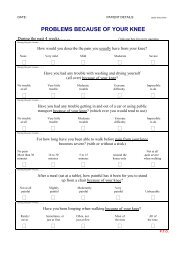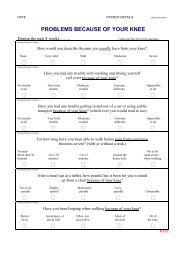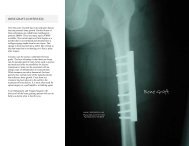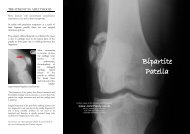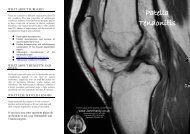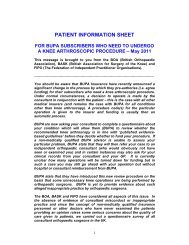Golfers Elbow
Golfers Elbow
Golfers Elbow
Create successful ePaper yourself
Turn your PDF publications into a flip-book with our unique Google optimized e-Paper software.
GOLFER’S ELBOW<br />
(MEDIAL EPICONDYLITIS)<br />
INTRODUCTION<br />
Tendons are cords of living tissue that connect muscles<br />
to bone. They act as the cables that allow joints to move<br />
at a distance from muscular contraction. This gives a<br />
mechanical advantage. Golfer’s elbow is a painful<br />
condition affecting the tendons that attach the muscles<br />
of the front of the forearm to the arm. These muscles<br />
act when gripping in the power grip position. Golfer’s<br />
elbow arises not just from Golfing or using too small or<br />
large a grip on your Golf club. It can be caused by any<br />
repeated twisting movements of the hand and wrist for<br />
example when using a screwdriver. It is common in<br />
patients who have manual occupations. Golfer’s elbow is<br />
also known as medial epicondylitis to doctors. The<br />
condition most commonly occurs in people aged<br />
between 35 and 55. It is most common in males with a<br />
manual occupation. It is most common in the right<br />
hand.<br />
WHAT CAUSES IT?<br />
Predisposing factors to the tendon damage and healing<br />
inflammation that results are rarely a single injury such as<br />
a blow to the arm and more commonly overuse.<br />
Overuse causes microscopic tears in the tendon. Causes<br />
include swimming, gardening, throwing sports and golf.<br />
Also, manual occupations that involve repetitive turning<br />
or lifting the wrist, such as plumbing bricklaying, using<br />
scissors or shears cause it. In attempt to heal the tear<br />
inflammation occurs and it is this inflammation that is<br />
the cause of the pain. Rupture of the tendon<br />
paradoxically results in an earlier cure. Rarely it is caused<br />
by gout (more common if both elbows are affected).<br />
HOW IS IT DIAGNOSED?<br />
There is a clear history of pain first thing in the morning<br />
getting better with exercise. The pain is intermittent at<br />
first but may become continuous and affect sleep. There<br />
may be tenderness over the broad origin of the forearm<br />
muscles on the outside of the elbow. If you have severe<br />
elbow pain, can't move the joint or have any loss of<br />
feeling, you should seek medical treatment urgently. This<br />
may be due to infection of the joint rather than Golfer’s<br />
elbow.<br />
You will not usually be required to undergo X-rays, but<br />
they may be recommended to rule out other conditions,<br />
such as arthritis, that can cause elbow pain. If there is<br />
doubt to the diagnosis then your doctor will suggest an<br />
MRI scan. This gives an image of the soft tissues,<br />
including muscles and tendons, rather than the bones.<br />
HOW IS IT TREATED?<br />
Most people with mild symptoms of Golfer’s elbow can<br />
try conservative treatments like RICE (rest, ice,<br />
compression and elevation). In the acute phase elbow<br />
braces like the Donjoy “Surround” provides both the<br />
compression and the cold therapy if it is kept in the<br />
fridge overnight. Try pain killers, non-steroidal antiinflammatory<br />
drugs like<br />
ibuprofen. Physiotherapy has<br />
been shown to be as effective<br />
as a local anaesthetic, cortisone<br />
injection or elbow braces.<br />
Combine the three and you<br />
have rapid sustained relief.<br />
Your GP may refer you to a<br />
sports medicine doctor or a<br />
physiotherapist. For a Golfer’s<br />
elbow that is persistently painful a doctor may suggest a<br />
steroid injection. Physiotherapy should include exercises,<br />
ultrasound treatment, heat treatment, using an infra-red<br />
lampand help to design a rehabilitation programme.<br />
Most pain will go without any more than the treatments<br />
described within a year.<br />
WHAT ABOUT SURGERY?<br />
Surgical treatment is reserved for those who have severe<br />
pain, persistent symptoms after medical treatment, or<br />
who are at risk of permanent loss of occupation. The<br />
aim is to release the tendon at the elbow. A temporary<br />
tourniquet is used to make the operative field free of<br />
blood. If you are medically fit, have someone who can<br />
collect you and look after you over night after the<br />
operation, the operation can be done on a day case basis.<br />
However, if you have other medical problems such as<br />
diabetes, asthma or high blood pressure, you may have<br />
to stay overnight after surgery.<br />
WILL I HAVE TO HAVE A GENERAL<br />
ANAESTHETIC?<br />
The operation can be done under sedation and local<br />
anaesthetic (asleep). Your anaesthetist will advise you<br />
about the best choice of anaesthetic for you. In addition,<br />
local anaesthetic may be injected into your elbow while<br />
you are asleep to reduce the pain after the operation<br />
even if you go to sleep for the surgery. You will also be<br />
given pain-killing tablets to take home.<br />
WILL I HAVE A PLASTER AFTER?<br />
No, you will not have a plaster on. However, you<br />
may be prescribed or need to buy a Clinical<br />
Shoulder Immobiliser to wear for one or two weeks<br />
after surgery.



